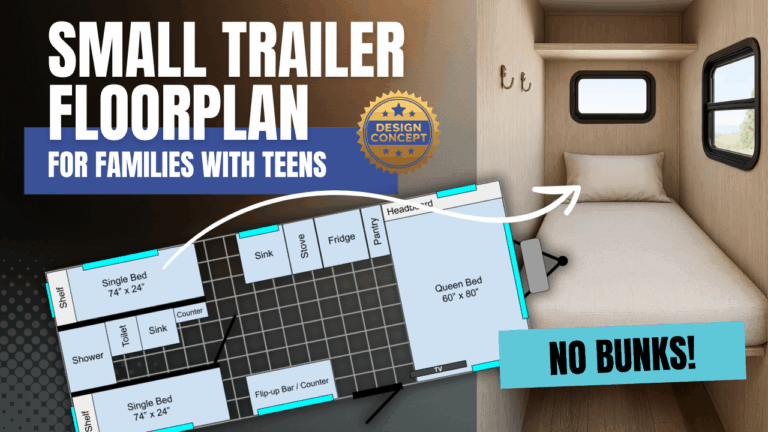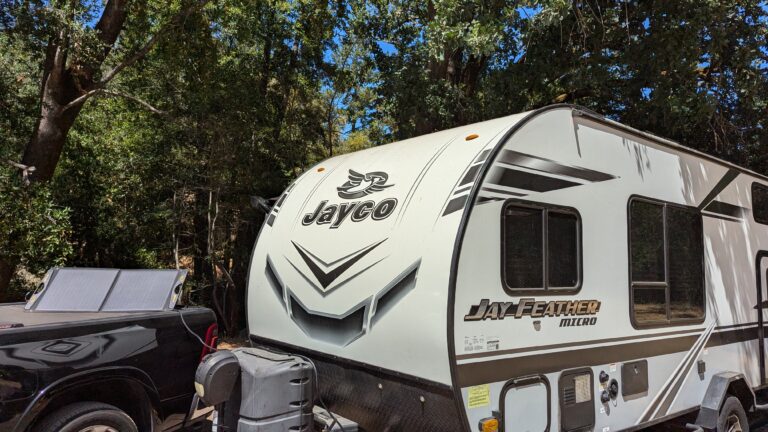Moisture can be a sneaky problem in travel trailers and RVs, especially during colder or rainy seasons. If left unchecked, it can lead to mold, mildew, and even damage to your rig’s interior. In this post, we’ll cover when to use a dehumidifier, when it’s not needed, the different types available, and how many you really need for your RV setup.
We’ll also share the rechargeable dehumidifier we personally use in our 20-foot travel trailer. We love that it’s compact, safe, and perfect for dry camping.
Rogina Roaming is supported by its audience. When you purchase through links on our site, we may earn an affiliate commission at no extra cost to you.
When to Use a Dehumidifier
Ideally, you want to keep the humidity in your RV or trailer between 40–45%. If it’s higher than 50%, it’s time to use a dehumidifier.
While not everyone travels with a humidity monitor, there are plenty of signs that indicate moisture levels are too high.
Here’s when you should use a dehumidifier:
- Humidity above 50%.
If you do have a temperature or humidity gauge, this is your best indicator. - Condensation on windows.
This is the most common sign, especially in the morning. If you wake up to foggy or wet windows, that’s a clear signal you should’ve had a dehumidifier running overnight. It’s not too late to start using one at that point. - Cooking or showering indoors.
Steam adds moisture to the air. Running a dehumidifier during or after these activities can help prevent buildup. - Sleeping in cold temperatures (under 40°F).
Cold air and propane heaters cause moisture to condense inside. If you’re camping in cold weather or keeping windows closed overnight, you’ll want a dehumidifier running. - Camping in rainy or humid seasons.
For us in Northern California, that’s usually November through April. More rain means more moisture in the air, and less ventilation in the trailer. - Camping near the coast.
Coastal air is naturally humid. Even with windows open, moisture can accumulate quickly, so a dehumidifier is a must in these regions.
When NOT to Use a Dehumidifier
You don’t need to use a dehumidifier all the time. In fact, air that’s too dry can irritate your skin and sinuses.
Here’s when you can safely skip it:
- Humidity below 30%.
If the air is already dry, adding a dehumidifier can make it uncomfortable inside. - Good ventilation.
When you can keep your windows or roof vents open and there’s steady airflow, you usually don’t need a dehumidifier. - Summer camping.
In most regions, the air is naturally drier during summer months. - Dry climates.
Areas like deserts or the inland west rarely require dehumidifiers, the air alone does the job.
Types of Dehumidifiers
There are two main types of dehumidifiers suitable for RVs and travel trailers:
1. Plug-in electric dehumidifiers
This style of dehumidifier use a small motor and drainage bucket to collect moisture. While they’re effective, they require a 110V outlet and are better suited for full hookups or long stays at powered sites.
2. Rechargeable dehumidifiers
This is what we prefer. These units use color-changing silica beads to absorb moisture. When the beads turn from orange or yellow to dark purple or black, it’s time to recharge them.
Rechargeable units only need to be plugged in while recharging. Once refreshed, they’re ready to go without power. This makes them perfect for dry camping and off-grid use.
We used to rely on the Eva-Dry E500, which worked well but lacked an auto shutoff. It got extremely hot during recharging and eventually burned itself out from overheating.
Now, we use the Afloia Mini Dehumidifier, and it’s been a game-changer. It sits on a base station that automatically shuts off when recharged, keeping it safe and efficient. Within a few hours, the beads return to their pale orange color and it’s ready to go again.
To make things easy, we keep two dehumidifiers on hand. That way we can have one in use and one stored in a sealed Ziploc bag to prevent it from absorbing moisture when not needed. When one needs recharging, we do it outside the trailer so the released moisture doesn’t go back into the air inside.
How Many Dehumidifiers to Use
We did some testing in our 20-foot travel trailer using a Ruuvi temperature and humidity sensor to compare results.
We found that one small rechargeable dehumidifier works great for a trailer this size. Occasionally, on colder or wetter nights, we’ll use a second one to help pull moisture out faster, especially if the first wasn’t fully charged.
Your results may vary depending on your region and trailer size, but for most small to mid-size trailers, one dehumidifier is plenty. Having a second on hand just makes it easier to rotate between them for longer trips.
Conclusion
A dehumidifier is one of those small items that can make a big difference in your RV comfort and maintenance.
Use one when humidity is high, you’re camping in cold or wet conditions, or anytime condensation builds up. But skip it when the air is naturally dry or you have good ventilation. Balance is key.
For our 20-foot travel trailer, the Afloia Mini Dehumidifier has been the perfect fit because it is compact, safe, and ideal for dry camping.



